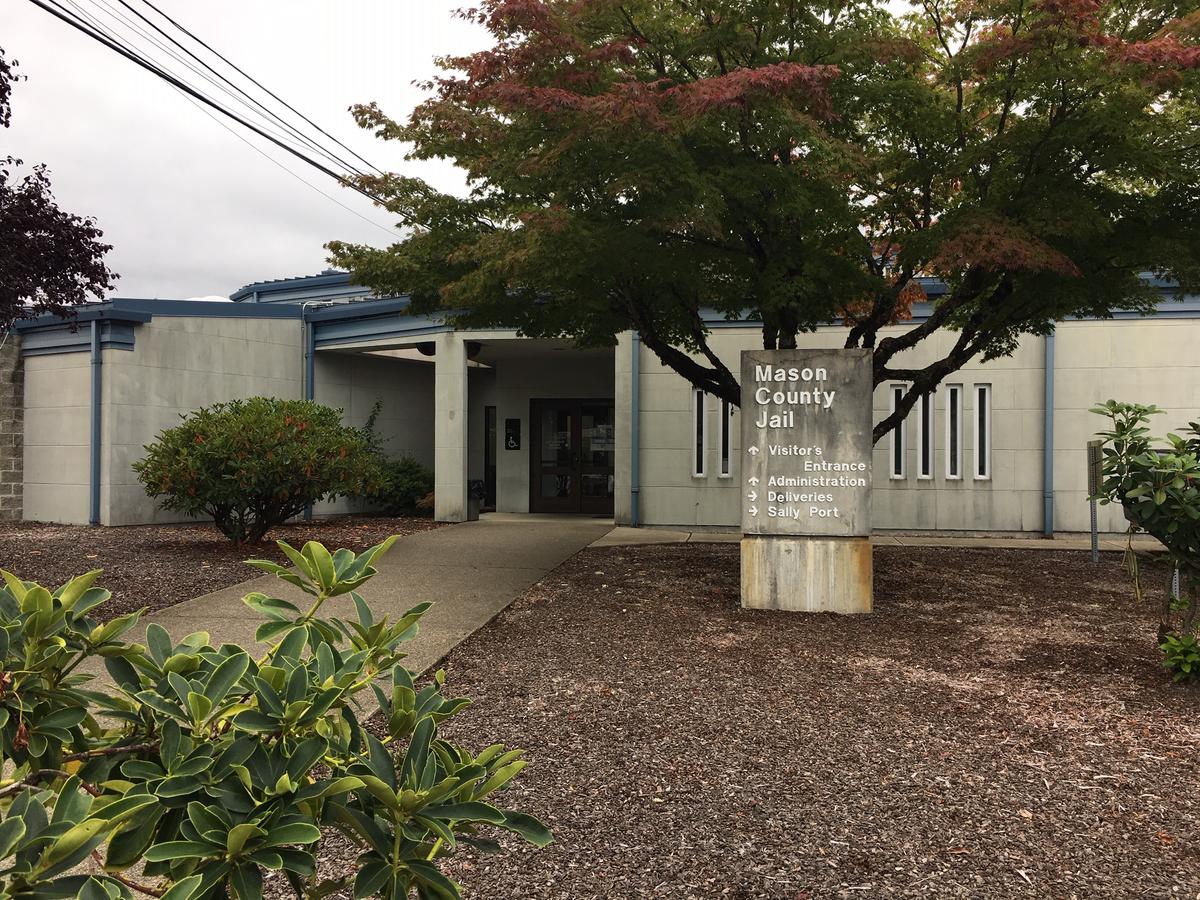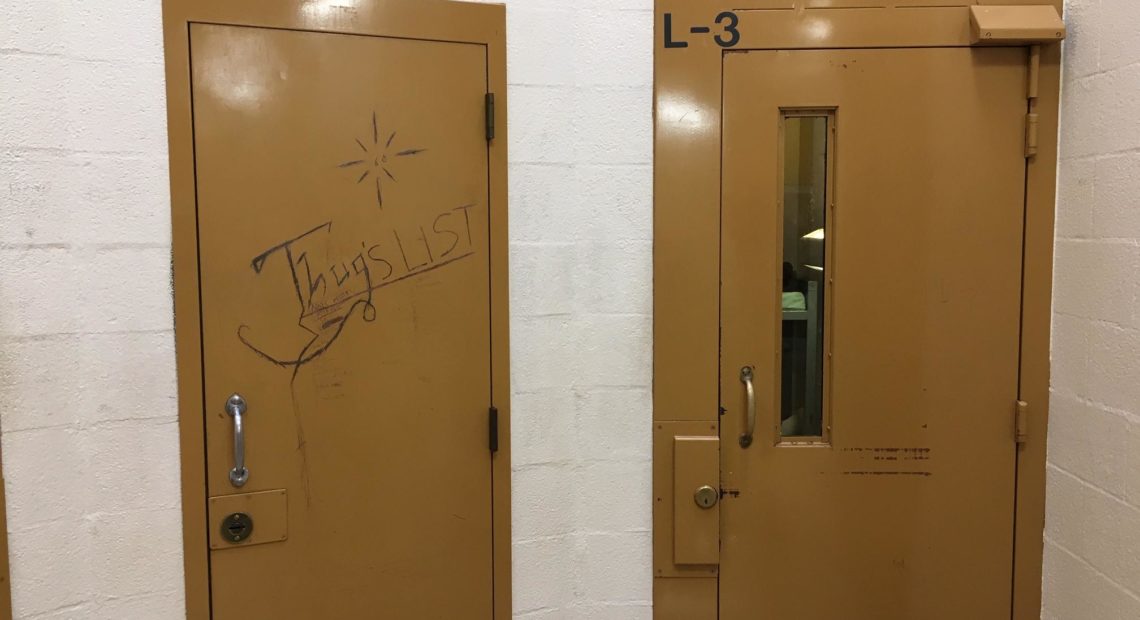
Booked And Buried: Aging Northwest Jails Endanger Lives, But Replacing Them Is Controversial
Listen
NOTE: This story is part of an ongoing reporting project by public radio stations in the Northwest examining deaths in county jails. See more from the “Booked and Buried” series here.
The day the brand new Mason County, Washington jail opened in 1985, it was already full. The previous jail on the top floor of the courthouse held just over 40 inmates. The new facility wasn’t much bigger.
Nearly 35 years later, the one-story cinder block jail located in the town of Shelton now holds about 90 inmates on any given day. A few years back, as many as 150 people were crowded into the facility.
“When you have a jail that’s designed to house 46 people and you have 150 people in it, there’s no way you can keep it safe,” said Chief Deputy Kevin Hanson of the Mason County Sheriff’s Department. “Bad things are going to happen.”
Bad things did happen. In 2013 and again in 2015, inmates in the Mason County Jail died by suicide. Since then, Sheriff Casey Salisbury has instituted booking restrictions. As a result, the jail turns away a lot of people to keep so it can stay at what Hanson calls “functional capacity.”
RELATED: The Northwest Has A Mounting Death Toll Inside County Jails
Hanson, who took over as jail director in September 2016, said the facility is now “safe and controlled,” but conditions are still far from ideal.
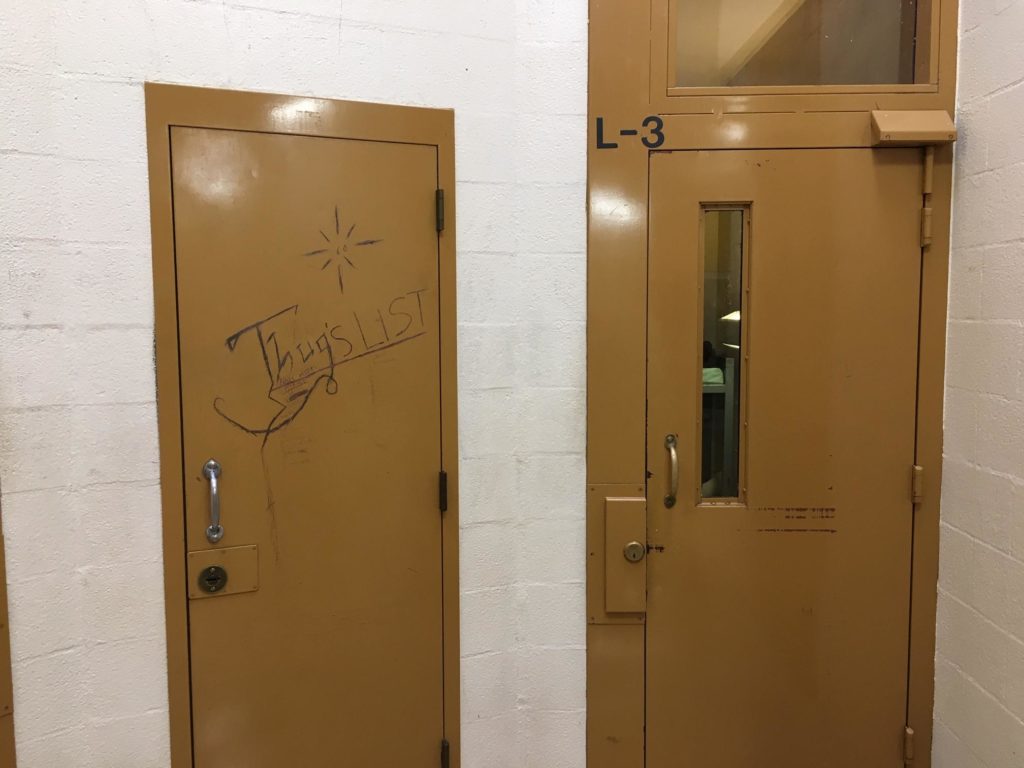
Jailhouse graffiti is common in the Mason County Jail which opened in 1985. CREDIT: Austin Jenkins/N3
On a recent tour, he pointed to inmates triple-bunked in a cell originally built for one. He said the holding cells in the booking area are often used for long-term housing for higher-risk inmates. Women are held behind chain link fencing in a back part of the jail that’s much colder. To compensate, the staff gives them extra blankets.
During the tour, Hanson offered a string of adjectives to describe his jail: “antiquated, outdated, inefficient, expensive.”
The story of the Mason County Jail is one that’s playing out across the Northwest. It’s the story of county jails that were built decades ago — many in the 1980s — during the run up to the tough-on-crime era, when the focus was on punitive rather than rehabilitative justice. It’s the story of jails that have outlived their usefulness and, in many cases, are overcrowded and understaffed.
It’s also the story of jails that are often unsafe. Between 2008 and 2018, more than 300 people died after being taken to a county jail in Washington or Oregon, according to an investigation earlier this year by OPB, KUOW and the Northwest News Network. Nearly half died by suicide.
During that same time period, the Washington Counties Risk Pool, representing 26 of Washington’s 39 counties, paid out more than $11.5 million stemming from inmate death claims.
For some, the condition of Northwest jails has reached a crisis point.
In November 2017, staff at the Stevens County Jail in Colville, Washington, picketed over wages and conditions in the jail.
In April, Sheriff Dave Ward of Harney County, Oregon, said he would resign at the end of the year, in part because of the condition of his jail and a lack of funding.
“I am no longer willing to accept the civil liability associated with the failure to appropriate fund/staff our jail, search and rescue, or law-enforcement services to our community,” Ward wrote at the time.
Last October, Bill Larson, the interim director of the Chelan County Jail in Wenatchee, Washington warned in a report that “the general design of the main facility is inherently flawed – it’s multiple floors and network of cells basically conceal, rather than reveal, the inmates and their activities from … staff.”
Larson, a retired state patrol captain, found that inmates regularly manufactured alcohol, consumed drugs, damaged property and assaulted each other. Inmates also frequently attempted suicide.
“It’s not an everyday occurrence, but it’s not extremely rare either,” Larson said in an interview. “Inmates will fashion some kind of a noose and try to hang themselves.”
In September 2017, an Army veteran named Jeremy Lavender died by suicide in the Chelan County Jail. Since then, Larson said his staff has intervened to save the lives of a number of suicidal inmates. But he’s concerned the conditions in the jail could lead to another death.
“I’m comfortable in saying that it’s not a matter of if, it’s a matter of when,” Larson said.
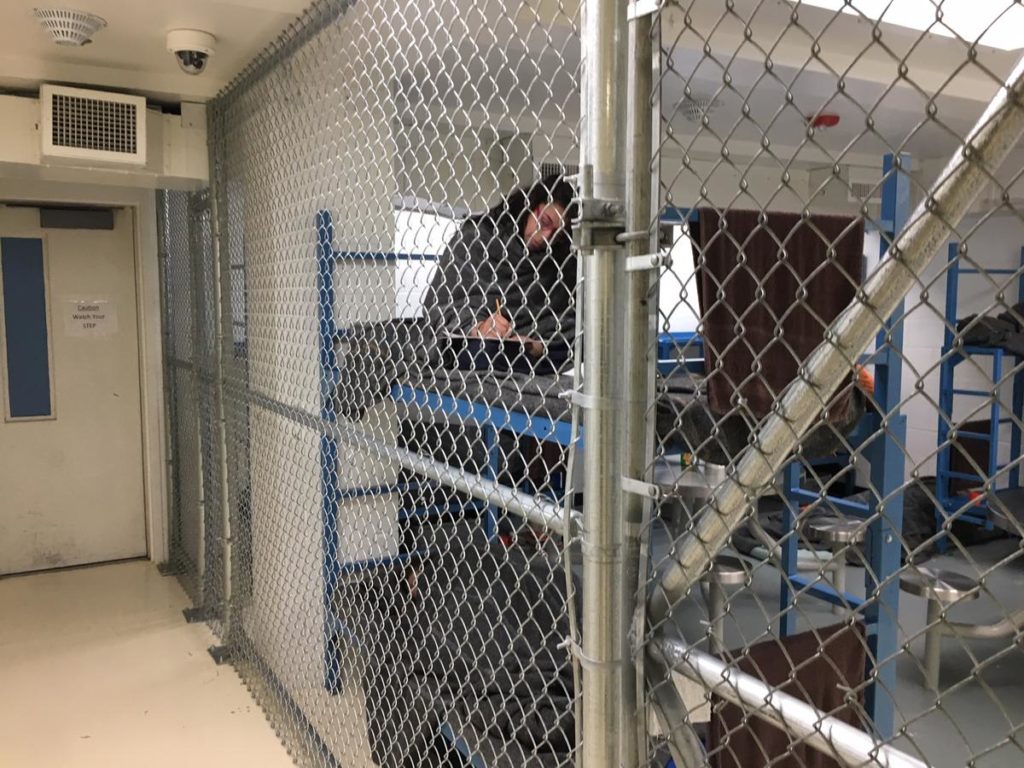
Women inmates at the Mason County Jail in Shelton, Washington are held behind chain link fencing and given extra blankets to ward off the cold. One inmate said the nickname for the unit is the “dog kennel.” CREDIT: Austin Jenkins/N3
In an effort to make the existing jail safer, Larson has reorganized the leadership structure and secured funding for an additional sergeant. He’d like 13 more staff. He said plans also are underway to install more cameras in the jail. But Larson sees these investments in the existing jail as stop-gap measures.
“We’ve hit that point to where we have to really start seriously thinking about building a new jail and how to go about that. And that’s going to be a huge undertaking,” Larson said.
But building new jails is costly and, often, controversial.
“Sticker shock” is how The Columbian newspaper described the reaction among officials in Clark County, Washington when they learned this past summer that it might cost $400 million to build a new jail.
No less shocking was the recent $170 million estimate to build a new jail in Jackson County in southern Oregon.
In Whatcom County, Washington voters have twice in recent years rejected levies to build a new jail despite the local sheriff, Bill Elfo, warning that conditions in the 1980s-era jail make it difficult to operate the facility in a “safe, humane and constitutional manner.”
New jails have been built in places like Thurston and Yakima counties in Washington. But those efforts have been fraught. In Thurston County, the new jail didn’t open for five years because they couldn’t pay to staff and operate the facility. In 2011, a budget shortfall forced Yakima County to close its 4-year-old jail, which had been built to house overflow inmates from King County.
A more successful model is South Correctional Entity (SCORE), a multi-jurisdictional jail in south King County that opened in 2011 to serve misdemeanor inmates from several smaller cities. Those cities shared in the expense of building and operating the facility.
But most counties have found the cost to build a new jail prohibitive.
“I can tell you that $30 to $50 million for Mason County to build a jail will be just about the limit of every available tax that’s available,” Hanson said.
In 2016, Washington state Rep. Roger Goodman, the Democratic chair of the House Public Safety Committee, introduced legislation to create a legislative task force on jail conditions and standards. The bill didn’t pass, but Goodman nonetheless convened an informal workgroup to study how to improve jails.
The consensus, he said, was the state should develop statewide jail standards – or require jails to meet national standards. But the task force also recognized that older facilities were inadequately designed and that retrofitting them or building new ones was cost prohibitive given other priorities, like funding mental health.
“What has happened since we established the workgroup and looked at the possibility of establishing standards, is that more people have died in jail and more people’s rights have been violated and we haven’t done anything legislatively,” Goodman said in an interview earlier this year.
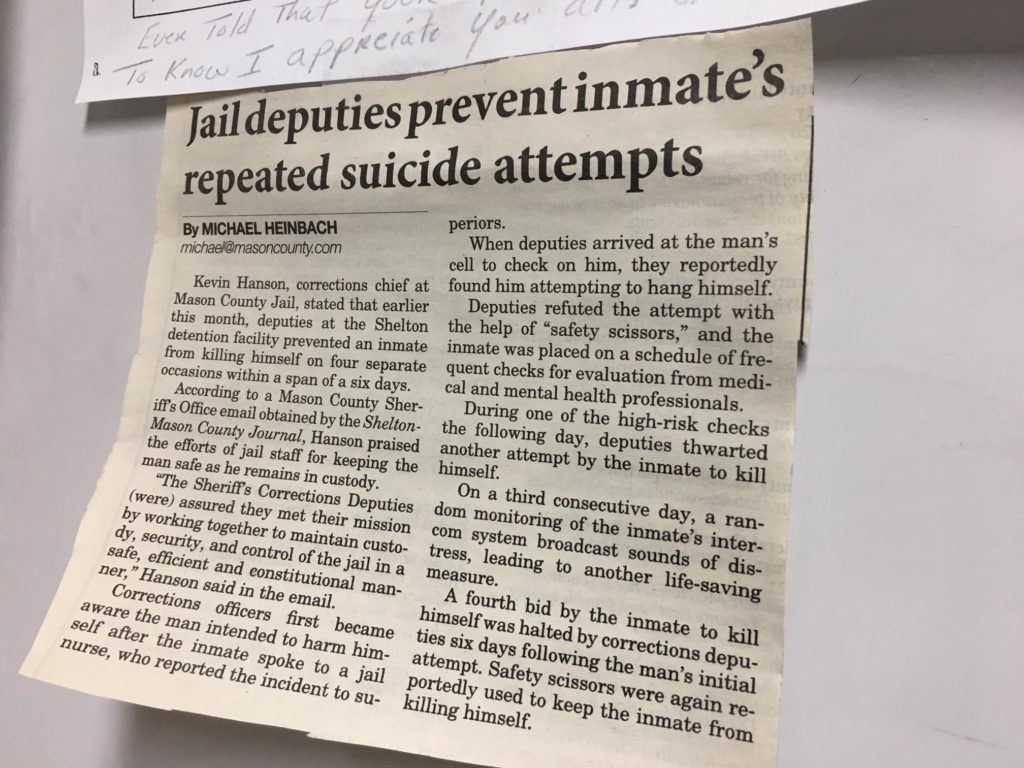
A newspaper article hanging in the Mason County Jail office talks about suicide attempts in the jail. CREDIT: Austin Jenkins/N3
Goodman also said there was discussion of requiring Washington jails to be accredited, but that too would be costly. The Washington Association of Sheriffs and Police Chiefs (WASPC) runs a voluntary jail accreditation program. But just three Washington jails, including SCORE, have earned accreditation. A fourth, Snohomish County, which experienced 21 inmate deaths over 10 years, is in the process of becoming accredited.
In a statement, WASPC Executive Director Steve Strachan acknowledged that some Washington jails lack adequate funding to ensure the safety and security for both inmates and staff. He urged a joint state-local effort to address the issue.
“Rather than just responding to bad incidents or litigation, we stand ready to partner with the state and local policy makers in working together to fund the necessary staffing, training and physical spaces to enhance safety where it is needed,” Strachan said in his statement.
Beyond the staggering costs, many criminal justice reform activists oppose the idea of building new jails, saying more jail capacity will translate to more people behind bars.
That debate is playing out currently in Spokane County, Washington where eight inmates died over a 14-month period, sparking renewed calls for a modern jail to be built.
Annemarie Frohnhoefer is a former member of the Spokane Regional Law and Justice Council’s racial equity committee. Last January, she wrote an op-ed in The Spokesman-Review newspaper headlined: “New jail won’t solve societal problems.”
Frohnhoefer said jails present a conundrum. On the one hand, they can make the public safer. But on the other, harm can come to the people inside them.
“So you really have this friction between public safety versus individual welfare and no one’s really decided how to balance those two yet,” Frohnhoefer said.
Frohnhoefer added that any conversation about a new jail should happen in the context of a shift away from mass incarceration. For her, that means a focus on restorative justice and significant investments in diversion programs to keep people out of jail in the first place.
If a new jail is ultimately built in Spokane County, she said, it should look a lot different from jails of the past.
“We’re looking at what does a post-mass incarceration facility look like,” Frohnhoefer said.
In Mason County, Washington, Chief Deputy Hanson said he supports more diversion and more programming in the jail to help people while they’re locked up. But he said his current jail doesn’t have the space to offer extensive programming. Hanson also noted that there are more than 5,000 people in Mason County with warrants for their arrest.
“The biggest problem is that people that should be arrested aren’t getting arrested because there’s no room at the inn,” he said.
Hanson said recently there’s been talk of building a new regional jail with neighboring Grays Harbor County. A consulting firm has been hired to study the idea, but it’s not yet clear if a joint facility is feasible or if the counties could afford to build it.
Related Stories:
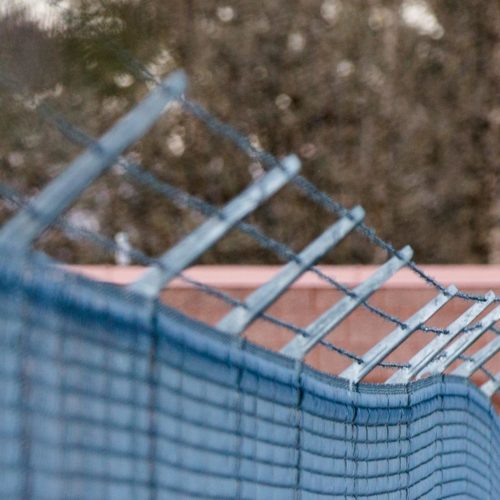
Booked And Buried: Case Of Lorenzo Hayes Shows It’s Not Easy Getting Answers To Jail Deaths
In other words, jail deaths are a local matter. It’s up to the jail director, the sheriff or other county officials to decide how an in-custody death should be investigated. The state has no role and no oversight of that investigation. The result is jail death investigations have no guarantee of independence, oversight or necessarily accountability.

He Died By Suicide In Solitary Confinement. Now Washington Will Pay $500K In Settlement
The state of Washington has agreed to pay $500,000 to settle a lawsuit brought by the family of a 29-year-old man who died by suicide in an isolation cell at the Airway Heights Corrections Center near Spokane in May 2014.

Booked And Buried: Jail Suicide Epidemic Doesn’t Extend To Northwest Prisons
Between 2008 and 2018, suicide accounted for 47% of jail deaths with a known cause in Oregon and Washington, according to an investigation by OPB, KUOW and the Northwest News Network. But an analysis shows the region’s prisons aren’t plagued by the same crisis.

